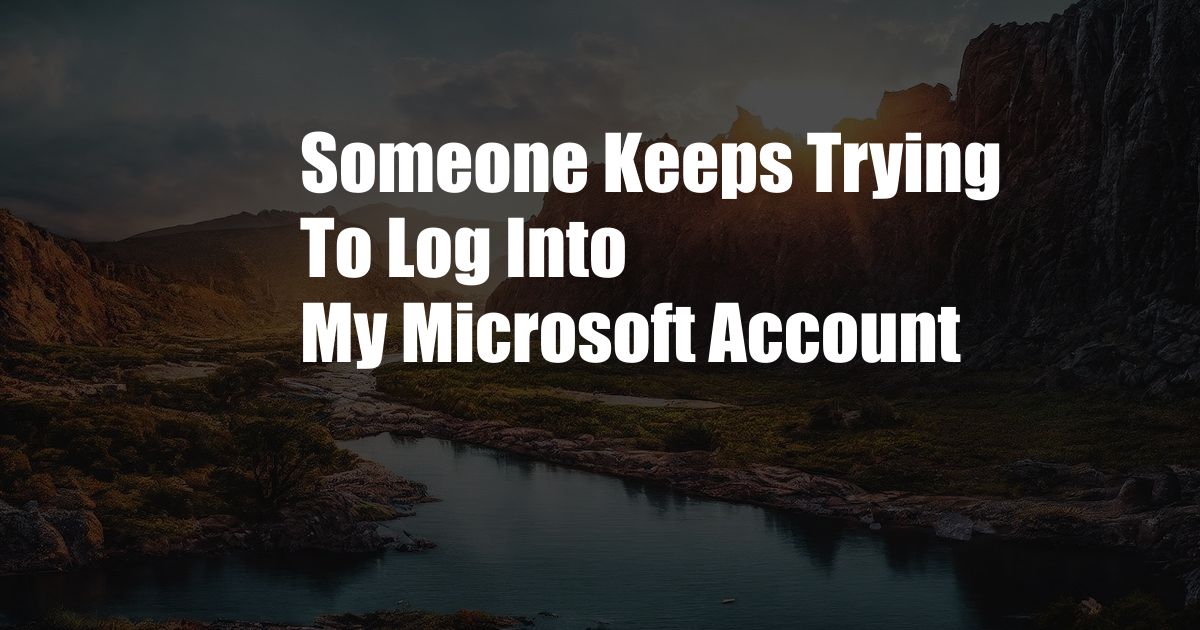
Someone Keeps Trying to Log into My Microsoft Account: A Comprehensive Guide to Account Protection
Identity theft is a serious crime that often manifests through the relentless attempts to access or take over someone’s online accounts. Through phishing scams or malicious software, these perpetrators are seeking to steal personal information, financial data, or even use your account for their nefarious activities.
If you find yourself facing this predicament, it’s imperative to remain calm and take immediate action. In this comprehensive guide, we’ll delve into the topic of unauthorized access to Microsoft accounts, providing you with a complete understanding of the issue, preventive measures, and effective solutions.
Understanding Unauthorized Account Access
Unauthorized account access occurs when an individual other than the authorized user gains access to a particular account without the user’s knowledge or consent. This can be a highly unsettling experience, as it can lead to a wide range of security breaches, such as identity theft, financial fraud, or personal data compromise.
In the context of Microsoft accounts, unauthorized access can stem from a variety of sources, including hacking, phishing attacks, malware, or even insider breaches. It’s important to recognize the signs of unauthorized access to take timely and appropriate action. Some common indicators include:
- Unusual login attempts from unknown locations or devices
- Changes to account settings or personal information without your knowledge
- Suspicious emails or messages requesting sensitive data
Protecting Your Microsoft Account
While unauthorized access to online accounts can be a daunting issue, there are a number of proactive measures you can take to protect your Microsoft account and safeguard your personal information:
Enable Two-Factor Authentication: This added layer of security requires you to provide a second form of verification, such as a code sent to your phone, when logging into your account. It significantly reduces the risk of unauthorized access, even if your password is compromised.
Use Strong Passwords: Avoid using easily guessable passwords such as your name, birthdate, or common words. Choose complex passwords that include a mix of uppercase and lowercase letters, numbers, and special characters.
Be Cautious of Phishing Attacks: Phishing scams involve deceptive emails or messages that aim to trick you into providing sensitive information. Never click on links or open attachments from suspicious sources. If you’re unsure about the legitimacy of an email, contact Microsoft directly for verification.
Keep Software Up to Date: Regular software updates often include security patches that fix vulnerabilities and protect against malware. Ensure that your operating system, browser, and antivirus software are always up to date.
Monitor Your Account Activity: Regularly review your account activity, including login history and recent changes. If you notice any suspicious activity, report it to Microsoft immediately.
Responding to Unauthorized Access
If you suspect that your Microsoft account has been accessed without your authorization, it’s crucial to take immediate action:
- Change Your Password: Reset your password to a strong and unique one to prevent further unauthorized access.
- Enable Two-Factor Authentication: If you haven’t already, enable two-factor authentication to add an extra layer of security.
- Report the Incident: Notify Microsoft about the unauthorized access by contacting their support team. Provide as much detail as possible, including any suspicious activity or communications you’ve received.
- Monitor Your Accounts:
Keep a close eye on your financial accounts, credit reports, and other online services linked to your Microsoft account. Report any suspicious activity or unauthorized transactions promptly.
- Seek Professional Help: If you’re concerned about your identity being stolen or compromised, consider reaching out to a reputable identity theft protection service for guidance and assistance.
FAQ on Unauthorized Microsoft Account Access
Q: What should I do if I receive a suspicious email claiming to be from Microsoft?
A: Never click on links or provide sensitive information in response to such emails. Report the email to Microsoft and delete it.
Q: How can I tell if my Microsoft account has been compromised?
A: Look for unusual login activity, changes to account settings, or suspicious emails or messages. Regularly review your account activity for any irregularities.
Q: What are the potential consequences of unauthorized account access?
A: Unauthorized account access can lead to identity theft, financial fraud, data breaches, and other serious security risks.
Q: What steps can I take to prevent unauthorized account access?
A: Enable two-factor authentication, use strong passwords, be cautious of phishing attacks, keep software up to date, and monitor your account activity.
Q: Who should I contact if I suspect my Microsoft account has been compromised?
A: Report the incident to Microsoft’s support team and seek professional help from a reputable identity theft protection service if necessary.
Conclusion
Protecting your Microsoft account is essential for safeguarding your personal information and online security. By implementing proactive measures, such as two-factor authentication and strong passwords, and responding appropriately to suspicious activity, you can significantly reduce the risk of unauthorized access and maintain control over your account.
If you’ve experienced or are concerned about unauthorized access, don’t hesitate to reach out to Microsoft and seek professional assistance. Remember, protecting your online accounts is an ongoing responsibility that requires vigilance and a commitment to cybersecurity best practices.